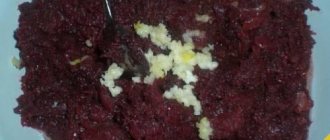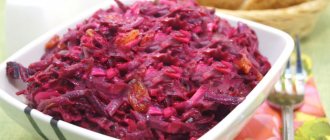Features of preparing beetroot botvinya
Beetroot botvinya is a Russian dish that was once called the “queen of cold soups,” but today it is undeservedly forgotten. It got its name due to the main ingredient, which is the edible grass tops.
It is best to cook botvinya in the hot season: the dish is served cold, it is perfectly refreshing in the heat, quenches thirst and tones. The recipe requires the use of fresh beet tops, herbs and young vegetables that are just ripening in the garden.
Before preparing botvinya, beets are disassembled into petioles and roots, namely roots, stems and tops. The vegetable is used to make a sour beetroot sauce for the dish, giving it a bright ruby color. The stems act as a textural filler for cold soup, as they crunch perfectly, and the leaves act as a thickening filler, the use of which is required for greater density of the food. According to the recipe, the greens are boiled, then chopped with a knife or pureed using a sieve.
Traditionally, a decoction of beet tops and very sour kvass are used as the basis of the dish. Meat, chicken or fish broth is often added to the filling. In addition, there are options for preparing beetroot botvinya in water.
Cold soup is considered incomplete without fish. In the classic version, the dish is accompanied by salted salmon fish (salmon, salmon, sturgeon), which is served on a separate plate along with crushed ice. The main presentation of the soup is with crayfish tails.
There are also many recipes for making botvinya that involve boiling fresh fish and adding portioned pieces directly to the plate before serving. Cold beet soup with chicken or beef is prepared using the same principle. Often shrimp, crabs or crayfish necks are added to it.
Additional ingredients when preparing botvinya include cucumbers, radishes, spinach, sorrel, green onions, wild garlic and even young nettle leaves, potato cubes or fried onions and carrots. The top of the dish is sprinkled with various herbs (dill, parsley) and decorated with a chicken egg cut into quarters or halves of a quail.
To achieve a richer and brighter taste, the soup is flavored with mustard, lemon juice, ground black pepper, horseradish leaves or root are added for pungency and aroma, and a clove of garlic is squeezed into a plate. If the dish turns out to be too sour, you can add a little sugar.
Interestingly, the classic recipe for beetroot botvinya also involves adding crushed ice to a bowl of cold soup, which is served on a separate plate.
Note! Assemble the tops directly in a plate: first lay out the tops, herbs, vegetables, then fill them with a base made from kvass and beetroot filling, place a portion of meat and crayfish necks on top, add horseradish, a slice of lemon and decorate with a boiled chicken egg. Finish decorating the dish with a drop of sour cream. Salted red fish and crushed ice must be served on separate plates.
Description and difference about ordinary beets
What is it and what is the name of the type of chard? The second name of the species is chard. This is a subspecies of common beet. There are two known types of this vegetable, namely leaf and petiole.
Attention : Swiss chard is distinguished by a lush, voluminous basal rosette, and well-developed leaves sit on thin petioles. The second, petiole, also has its own characteristics. First of all, these are dense, fleshy petioles, suitable for food.
Both species have a taproot. In addition, chard has a high yield . In large farms it reaches 70-100 t/ha.
Chard differs from the usual types of beets in the absence of a root crop. This plant is valued for its leaves and petioles, known for their nutritional value.
We recommend watching a video about the features of Swiss chard:
TOP 5 beetroot botvina recipes
As soon as you have young beets in your garden, start preparing the botvinya. This is a very healthy dish, which is also wonderfully refreshing in the summer. There are also many recipes for such cold soup that everyone will like.
Classic recipe for botvinya with fish
To prepare botvinya, it is better to use young beets, as they contain more juice. In addition, the dish in this case turns out to be more saturated in color. The traditional version uses chicken eggs, but they can be replaced with quail eggs - they look more beautiful on plates. Fish for botvinya is served separately, along with rye bread.
- Calorie content per 100 g - 100 kcal.
- Number of servings - 2-3
- Cooking time - 1 hour
Ingredients:
- Beets - 2 pcs.
- Beet tops - 1 bunch
- Salted red fish - 200-250 g
- Dill - to taste
- Green onions - to taste
- Cucumbers - 2 pcs.
- Radish - 200-250 g
- Chicken egg - 2 pcs.
- Water - 1.5 l
- Salt - to taste
- Mustard - to taste
- Horseradish - to taste
Step-by-step preparation of classic botvinya:
- We start by dividing the beets into their components - roots, stems, leaves. Peel and cut the vegetable into strips, you can also chop it on a coarse grater.
- Fill half the beets with water and cook for 10 minutes.
- The second part needs to be marinated in a deep plate, poured with lemon juice and sprinkled with salt. Also, instead of lemon juice, you can take apple cider vinegar in the amount of 1 tbsp.
- While the vegetable is marinating, boil the eggs hard for about 10 minutes, then cool them in cold water.
- We cut the beet stems into 1 cm cubes, the leaves into 2-3 pieces, and then 0.5 cm across.
- Add the chopped vegetable stems to the pan with the boiled beets and boil again for 10 minutes.
- Next, add pickled beets to the dish and continue cooking the soup.
- After another 10 minutes, add the tops and cook for the same amount.
- While the beets and tops are cooking, you need to wash and chop the cucumbers and radishes. They can be immediately placed on plates.
- We also send finely chopped dill there, followed by green onions.
- After this, we begin preparing the fish. It needs to be cut into thin plates.
- If you want a more satisfying dish, add potatoes - the classic botvinya recipe allows it. Wash 2 potatoes, remove the skin, cut into cubes and add to the beetroot sauce.
- After the soup is cooked, it needs to be cooled well.
- At this time, peel and chop the eggs.
- All that remains is to assemble the dish: fill the plates, where cucumbers, radishes, dill and onions have already been placed, with cold beetroot filling, and place chopped eggs on top. To taste, you can add horseradish and mustard to the classic botvinya.
- Serve the fish slices separately, accompanied by rye bread.
Note! Before preparing beet leaves, it is recommended to wear gloves to avoid staining your hands.
Festive Botvinya with crayfish
An original recipe for botvinya, which is worthy of a festive table. The dish turns out truly magnificent and beautiful if you pay attention not only to the recipe for its preparation, but also to serving. We do not recommend adding sour cream!
Ingredients:
- Beets with tops - 3 pcs.
- Sorrel - a large bunch
- Spinach - a large bunch
- Fresh cucumber - 3 pcs.
- Radish - bunch
- Green onions - bunch
- Dill - half a bunch
- Chicken egg - 3 pcs.
- Fresh sturgeon or pike perch - 500 g
- Live crayfish - 4 pcs.
- White wine or apple cider vinegar
Step-by-step preparation of botvinya with crayfish:
- Before cooking the dish, beets must be divided into 3 components - roots, stems and leaves.
- Let's start pickling the beets. First you need to peel and cut the vegetable into thin julienne strips. You can also grind it on a grater. Place the chopped beets in a bowl, add salt, and pour over white wine vinegar (can be replaced with apple cider vinegar). Then the vegetable should be pressed down and left for 30 minutes.
- Next, you need to rinse the sorrel, remove the stems and throw it into pre-salted boiled water (1 liter). Chat it for half a minute, and you can throw it in a colander. Wait for the sorrel to cool slightly and puree it through a sieve; you can also use a blender for this purpose.
- Spinach should be prepared in the same way before cooking the botvina, but it does not need to be pureed: just chopped with a knife.
- The fish should be quickly simmered in very salty water, to which it is recommended to add vinegar. It is better to use sturgeon on the skin so that it does not fall apart. Once it has cooled, cut it into 1cm thick slices.
- Next, we begin preparing the crayfish. Boil 3 liters of water, add salt, dill, and throw in live crayfish head down. Wait until the water boils and cook them over medium heat. 10 minutes is enough. Next, the crayfish should be left in the same water to cool for another 10 minutes, after which remove them from the pan, clean the necks and claws.
- Boil 2 liters of water, throw in the pickled beets, pour out the juice they released, and let the liquid boil.
- Boil the beets for another 3 minutes over low heat and add the beet stems, which need to be cut diagonally.
- Wait until the dish boils again, simmer for 3 minutes and add the beet leaves, sliced thinly.
- Let it boil again, cook for 3 minutes and add sorrel puree with spinach, then remove the pan from the heat and wait until the dish has cooled. Then we put it in the refrigerator to cool it as much as possible.
- At this time, it is necessary to chop cucumbers, radishes, green onions and dill, hard boil, peel and cut the eggs.
- When all the ingredients are prepared, we begin to assemble the dish. To do this, put vegetables and herbs on plates, pour in cold beet broth, lay out crayfish necks and claws, a slice of poached fish and quartered eggs.
Note! To prepare botvinya for this recipe, it is recommended to use sturgeon or pike perch (500 g), but you can also replace it with lightly salted salmon or trout (300 g). However, in this case, a slice of fish is not placed directly on the plate, but is served separately along with lemon.
Botvinya with meat
The recipe for botvinya with meat is very simple and does not involve any complex steps, it resembles borscht or beetroot soup, but in our case it will not be possible to get by with just one young root vegetable. Beet tops with stems are also used.
Ingredients:
- Beef – 500 g
- Onion - 1 pc. into the broth
- Carrots - 1 pc. into the broth
- Potatoes - 300 g
- Onion - 1 pc. for frying
- Carrots - 2 pcs. for frying
- Vegetable oil - 2 tbsp.
- Beetroot – 700 g young
- Sugar - 1 tsp.
- Vinegar - 1 tbsp.
- Bay leaf - 1 pc.
- Greens - to taste
- Salt - to taste
- Garlic - optional
Step-by-step preparation of botvinya with meat:
- First, prepare the rich broth - it serves as the basis of the soup. Rinse the meat and place in a saucepan, filling with cold water. Place the container on the fire and bring to a boil. While preparing the broth, skim off the foam using a slotted spoon.
- When she leaves, add vegetables: peeled and chopped carrots and onions. In addition, parsley and celery will help improve the taste and make it richer.
- Salt the broth to taste and simmer over medium heat until the meat is cooked. This will take approximately 1.5 hours.
- While the broth is boiling, prepare the vegetables: you need to peel the onions, carrots, potatoes, and disassemble the beets into their components - roots, stems, leaves. Peel the roots, wash them thoroughly, and cut them thinly. Wash the tops and remove dirt.
- Let's start preparing the frying, it will make our beet tops more flavorful. To do this, finely chop the onion, grate the carrots and fry the vegetables in heated vegetable oil, lowering the heat, until lightly golden.
- Before preparing the botvina, you need to strain the broth using a sieve: for further cooking it is taken clean. Remove the meat from the pan and cut into portions.
- Pour the clean broth into the pan again and bring to a boil.
- At this time, cut the potatoes into small cubes and throw them into the broth as soon as it boils. You also need to add frying to it.
- Next, cut the beet root into strips and 7-10 minutes after adding the potatoes to the broth, send them there too.
- To balance the taste, add a little sugar to the dish, and to achieve a slight sourness, add just a little vinegar; in addition, this will preserve the bright color of the dish.
- We chop the beet tops with stems and also add them to the soup, after which we cook the dish for another 5 minutes.
- Following the beet tops, add bay leaves and salt to the tops if you need to adjust the taste.
- Turn off the heat and leave the dish to steep under the closed lid.
- Pour the soup into bowls, add meat and herbs. If desired, you can squeeze out a clove of garlic.
Note! If you use chicken instead of beef to prepare botvinya, the cooking time of the dish will be significantly reduced.
Botvinya with kvass
This unique recipe for cold botvinya made from beet tops, noble fish and kvass will help you take a fresh look at an undeservedly forgotten dish that was once very popular. All your efforts will pay off in spades, because the soup really turns out to be unlike any other.
Ingredients:
- Bread kvass – 600 ml
- Salmon fillet – 300 g
- Spinach – 250 g
- Water – 150 ml
- Dill - 5 sprigs
- Parsley - 5 sprigs
- Beets - 2 pcs.
- Tops - 1 bunch
- Allspice - 3 peas
- Bay leaf - 2 pcs.
- Cucumber - 1 pc.
- Onion - 1/2 pcs.
- Lemon - 1/2 pcs.
- Green onions - 1/2 bunch
- Salt - 1 tbsp.
Step-by-step preparation of botvinya with kvass:
- Pour water into a small saucepan, salt it, add peppercorns, bay onions and peeled onions. Wait until it boils.
- Prepare the fish by cutting into large pieces and boil in boiling water for 20 minutes. After the specified time, place it in a bowl and leave to cool.
- Disassemble the beets into 3 parts - roots, stems and leaves.
- Fill a small saucepan with water, boil it and place the washed beet tops in it. It should be cooked for 3 minutes. Then drain in a colander and, after it has cooled, chop finely.
- Wash the spinach and boil in another saucepan for 20 minutes, turning the heat to low after the water boils. After the specified time, it should also be drained in a colander, and then, using a sieve, pureed.
- At the next stage, boil the beet root, wait until it cools, and cut into small cubes. You can also bake it if desired.
- After this, finely chop the cucumbers, chop parsley, dill and green onions
- Mix the onion with spinach puree, which should have cooled by now, add cucumbers, beet tops, and herbs. At this stage, add salt to the dish and add sugar if you intend to use sour kvass in the future.
- To the mixed products add a sliced lemon, beets, and pour kvass over the ingredients.
- Now you can start assembling the cold botvinya: put a portion of boiled fish, a slice of lemon on each plate and pour in the beetroot mixture with vegetables and herbs.
- Before serving, you can season the soup with crushed ice.
Botvinya with nettles
An original recipe for cold botvinya, which differs from the usual options by adding nettle leaves. The result of cooking is not only a tasty, but also an extremely healthy dish, since nettle and beet tops contain many vitamins and minerals necessary for the human body.
Ingredients:
- Fish – 500 g
- Beets - 2 pcs.
- Cucumbers - 2 pcs.
- Lemon juice - 1/2 pcs.
- Beet tops - 150 g
- Sorrel – 125 g
- Spinach – 125 g
- Nettle – 150 g
- Green onions - 30 g
- Dill - 30 g
- Beetroot broth - 250 ml
- Fish broth - 250 ml
- White kvass – 250 ml
- Bread kvass – 500 ml
- Salt - 1.5 tsp.
- Sugar - 1 tbsp.
- Mustard - 1/2 tsp.
- Horseradish - 1 tsp.
- Ground pepper - 1/2 tsp.
Step-by-step preparation of botvinya with nettles:
- We divide the beets into 3 components - roots, stems and tops, and wash them thoroughly.
- Boil the vegetable until tender. We will use the resulting broth as a base for the dish; do not forget to strain it before doing this.
- We clean the fish and cut it into large pieces.
- Next, put 1 liter of water in a saucepan, salt it, add bay leaf and put on fire. When it boils, add the fish pieces and boil for 2 minutes. After this time, we take out the fish and wait for it to cool. We proceed with the broth in the same way as with beet broth: it is also used as a base for botvinya.
- Next, put the spinach in boiling water and blanch for half a minute, then do the same with the sorrel and beet tops.
- Nettle leaves and beet stalks need to be blanched 2 times longer. As a result of scalding with boiling water, the nettle stops pricking and becomes soft.
- We wait for the greens to cool, and then chop them finely.
- At the next stage, cut the cucumbers and boiled beets into small cubes, chop the dill, parsley and green onions.
- After this, we prepare the base for the soup, mixing white and dark kvass, beet broth and fish broth in one container. Don't forget to add salt, lemon juice and a little sugar. Also, if desired, improve the taste with mustard and horseradish.
- Prepare the base for the botvinya: pour white and dark kvass, beetroot broth, and fish broth into a bowl. Don't forget to add salt, lemon juice and a little sugar.
- Now we begin to assemble the dish: put all the chopped ingredients in a bowl (tops, beets, vegetable petioles, cucumbers, nettles, parsley and dill), pour in the base for the tops, lay out portioned pieces of fish.
- To improve the taste, season the botvinya with mashed horseradish and mustard, and also add finely chopped ice.
Botvinya is often prepared using a steamed starter consisting of flour and leaven grounds. Make it a day before preparing the dish. To do this, rye flour (2-3 tbsp) is diluted with water (1-1.5 tbsp) in a clay pot and put in the oven for half an hour. After the specified time, when the mixture has boiled, it must be strained using a sieve, added chopped beet tops and poured with bread kvass (1-1.25 l). In this form, the mixture is left to sour, and after a day it is diluted with kvass and the preparation of botvinya begins.
Benefits and harms
Chard can safely be called a useful crop in all respects . More than a dozen polyphenolic antioxidants were found in its leaves, including kaempferol, which reduces the likelihood of developing cancer. Along with kaempferol, chard contains syringic acid, which is responsible for regulating blood sugar.
Just like beets, chard is known for its high content of betalains, powerful antioxidants. Swiss chard is rich in vitamins and macroelements. For example, just 100g of fresh leaves contain more than half the daily requirement of magnesium for our body. Chard helps improve the functioning of the cardiovascular system, cope with obesity, anemia and vitamin deficiency.
Despite all the benefits of chard, it is important to know that the proportion of vitamin K in its composition far exceeds the daily requirement. Its excess in the body leads to an increase in platelets and an increase in blood viscosity. This is especially dangerous for those who suffer from varicose veins or thrombophlebitis. Another substance that can not only be beneficial, but also harmful is oxalic acid.
Advice : Therefore, people with kidney or gallbladder problems are advised to boil chard before eating.
Video recipes for beetroot botvina
Botvinya is served in bowls and bowls as a first course. It is also customary to eat it after the first hot dish as a liquid snack, before starting the roast. It is served with fish and crushed ice on a separate plate, as well as 2 spoons. The first to sip the soup, the second to put ice on the plate. Fish is eaten with a fork, which should also be on the table. The bread is only rye.
0
- 0
Rate the recipe:
If you liked the recipe, then share it with your friends via social networks and leave your comment. By spending just 10 seconds of your time on two clicks on the social network button, you will help our project. Thank you!
Planting and care
Seed material . Chard seeds can be purchased at a specialty store. The cost ranges from 20-200 rubles per package, depending on the selected variety.- Boarding time . The optimal time for planting seeds is April, preferably the middle or end of the month.
- Choosing a landing site . A well-lit place is best. If there is not enough sunlight, the plant will accumulate nitrates.
- The soil . Almost any soil is suitable for planting chard - the main thing is that it is loose and moderately moist. Neither excessive dampness nor overdrying should be allowed.
- Landing . Before planting, the seed is soaked for a day for better germination. Seeds are planted in the ground at a distance of 2-5 centimeters from each other, planted to a depth of 2 centimeters. If planting is done too early, it is better to use covering material.
- Temperature . It is believed that the optimal temperature for growing leaf beets is 15-25 degrees, during the flowering period - 20-25. However, chard can tolerate heat up to +35 and light frosts down to -3. At high temperatures, the stems of the plant become pink, and at low temperatures, green.
- Watering . Chard is a moisture-loving crop; in dry soil its growth slows down significantly. The optimal watering schedule is every other day.
- Feeding . It is necessary to feed chard after each cutting of leaves or petioles. The best solution is urea solution (10g/10l) or humus.
- Other care measures . Swiss chard needs regular loosening and weeding. Loose soil will provide the roots with oxygen, and the absence of weeds will reduce the likelihood of diseases or pests.
- Harvesting . The harvest can be harvested within a month and a half after planting until late autumn. The leaves are cut off or simply broken off at the base along with the petioles.










